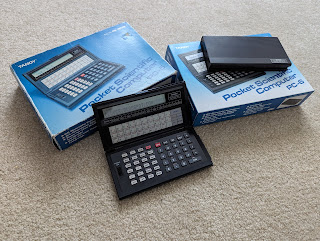But this particular odd little assembler dialect had the bureaucratic weight of the Japanese government behind it, because in 1969 what was then the Ministry of International Trade and Industry (MITI, 通商産業省) developed a completely artificial processor architecture to help ensure everyone taking the Information Technology Engineer Examination (情報処理技術者試験) would do so on an even keel. No one would have been an expert in this architecture or how to program it because we just made it up, reasoned the Ministry, so therefore no one will have an unfair advantage on the test.
Of course, that lasted only a few years before the specifications got out, and soon afterwards a handful of Japanese manufacturers had added it to their computers as a feature — including their pocket computer line. Through the magic of Tandy badge engineering, two of them made it to Radio Shack stores in the United States in the mid-1980s, perplexing a generation of larval nerds like me who couldn't understand what the heck it was doing there. While it was no secret the Tandy PC-5 and Tandy PC-6 Assembler feature was a fake, few people knew its history or ever did a detailed exploration. Let's dig into the dark and gloomy corners of this utterly bogus virtual CPU that a few real computers ran — sort of — and write our own cross-assembler and virtual machine so that future geeks can be just as befuddled.
